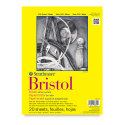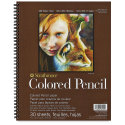If you have landed here to read about the best paper for colored pencil, it might be that you are less than satisfied with your colored pencil work.

You may have some of the best colored pencils—Faber-Castell Polychromos, Prismacolor Premier, Koh-i-Noor, to name a few.
Also, you may have the basics down: layering, blending shading, etc., but somehow you feel you can do better.
Maybe you wonder about the paper you’re using. Do you have the right paper to maximize results?
This post will give you information on the best kind of paper to use for optimal success in colored pencil art.
[This article contains product links for your convenience. They are affiliate links – Learn more here.]
Gotta Be “Toothy”
So, won’t any old drawing or sketch paper do? After all, we are using a colored pencil. Umm…. no.
Yes, you are using a colored pencil, but I like to think of colored pencil art as painting with a pencil point.
To that end, the surface of the paper you choose needs to have some “tooth”. Without tooth, all the best techniques in the world will produce a lack-luster piece of work! And I think all colored pencil artists would agree on that.
Tooth simply means the surface is textured to an extent—with “hills and valleys”. And there is great variation of this brand-to-brand.
Bristol Vellum
Have I done work on Strathmore’s Bristol Vellum? Sure. But I have to admit it’s mostly because it’s a quality product, which artists consider to be professional grade, and top artists sing its praises.
I save it for the special work—professional work or commissions—so I don’t use it every day. When I do pick it up to use it, honestly, it’s like I have to get used to it all over again.
In fact, I began a commission recently using it and as usual, wasn’t enjoying it at first. I thought, “Press on, after all, it IS a professional grade paper.” I finished the commission and it turned out great.
So, what don’t I like about it? Well, I just don’t think it’s toothy. It claims to have tooth but, in my opinion, it’s minimal, and it’s too smooth for my liking for colored pencil (even the vellum surface). When I layer, I find have to adjust my technique to accommodate it.
I can use it successfully, but I just don’t prefer this paper. But I do want to go on record as saying it is very sturdy and is a thick, heavyweight (100lb) quality paper. It takes erasing quite well, too.
Here is the link so you can check it out for yourself: Strathmore 300 Series Bristol Pad .
Again, it comes in two surfaces—be sure to choose the vellum, not the smooth, since the smooth is better suited to pen and pencil.
The Ideal Paper Should Not Be Too Toothy
Is there such a thing as too much tooth? Yes, I think so. For example, do not use pastel paper. This paper has significant tooth and is

Trying to complete a colored pencil piece on pastel paper would take forever. You’ll be layering and layering and layering.
The pic to the right shows a single layer of colored pencil applied on Pastel paper—on the left vs. my favorite vellum paper on the right to illustrate my point (ooo sorry for the unintended pun!)
Not that it can’t be done on the pastel paper, it can. And if you like lots and lots of layers, then go for it. But it really is meant for pastel use, not colored pencil—they call it “pastel paper” for a reason. The same goes for cold press watercolor paper as well, not good for colored pencil use.
Here is an additional resource on the topic of papers/surfaces; a great article from The Virtual Instructor –“All About Drawing Papers and Surfaces”. Just click on the article title to check it out.
Technique IS Important, Too
Basic colored pencil techniques are important, too, even if you have the best paper. By that I mean, remember it is always crucial no matter what paper you use, to begin all your projects with glazing (light) pressure. This allows the tooth to do its job helping you achieve optimal color-mixing, layering and blending.
[Here is my post on “Basic Colored Pencil Techniques” if you’d like to brush up on my tried-and-true techniques!]
Why is this important? Well, consider this… If you start off with a heavy pressure right off the bat, think about what that does to the tooth of the paper. Basically, you will fill in the “valleys” of the paper, but you will also flatten the “hills” (essentially damaging the tooth) and may even create unwanted grooves. This will prevent the tooth from grabbing any subsequent layer and mixing properly.
The result? You will see streaks, unevenness, grooves or obvious strokes in your work. Also, colors won’t mix properly because it will most likely keep hitting those unwanted grooves or simply lay on the top of the layer underneath and mix unevenly.

Go lightly and build up layers
In contrast, let’s consider going lightly to start off with. The tooth of the paper will grab the first light-pressure layer you apply.
Your color will deposit nicely into the “valleys” of the paper while leaving plenty of room for the paper to accept other colors as you layer additional colors.
When you apply additional layers this way, the tooth will gradually fill up consistently and with optimal mixing. (As the tooth fills up, I am gradually increasing my pressure, fyi.)
Tip: You can achieve light pressure layers more easily by holding your pencil away from the point as shown in this pic.
Remember, the tooth is there to help your art, so don’t squash it!
My Recommendations
The amount of tooth in the paper is a preference thing.
I would go with the Strathmore 400 Series Colored Pencil Pad, for a professional quality paper that does have a good tooth. This paper is specifically made for colored pencil.
Since I just finished up my pad of Strathmore Bristol Vellum, I will get a pad of this next.
But my favorite is the Neenah Paper Exact Vellum Bristol. This is a great everyday paper.
It is also very affordable. At just 3 cents/sheet (yes, I said $.03!), you can’t beat it. Compare this to 24 cents/sheet for the Strathmore brand colored pencils paper or the 33 cents/sheet for the Strathmore Bristol Vellum.
The Neenah Bristol vellum comes in a 250-sheet ream so you won’t run out anytime soon.
Drawbacks? It is a lighter weight—67#, a far cry from the sturdier 100# weight of the Strathmore Bristol Vellum. Also, it comes in a ream wrapped in paper so you will need to store it in some type of hard container to protect the paper.
But I consider these things small trade-offs for the affordability and performance!
Grab Some Tooth!
Hope this clears up a few things for you regarding choices for the best colored pencil paper.
OK, I know I’m harping, but tooth is very important in working with the medium of colored pencil. Make sure you have that no matter what brand paper you choose.
If you have been using a paper you like for colored pencil, please share in the comment box below.
And no worries, your email will never be shared.
You may also be interested in my post on blending: “6 Ways for How to Blend Colored Pencil” -===>Click here to read.
Have an artful day!
Elaine





Very much informative article. Thanks for your help
You are so welcome, Nina. Thanks for reading!
Hi, thank you for this article. I am an absolute beginner in this medium, so papers recommendation for practising, which are affordable, is very appreciated. About the Neenah Exact Vellum Bristol, I wonder if the paper listed below is the same paper? The descriptions look the same, but the packaging is different.
https://www.amazon.com/Vellum-Bristol-Brightness-Sheets-80218/dp/B006P1Z59O/ref=pd_ybh_a_1?_encoding=UTF8&psc=1&refRID=QNDJ9R2MADKNQRMBWYEK
Thank you.
Hi Dewi
You are so welcome. Glad I could help. And yes, I do think that paper is the same thing as what I use.
Elaine
Hi Elaine,
Thank you for confirming.
Best Regards,
Dewi
Not a problem, Dewi, glad to help.
Here are links to other relevant posts you may find helpful as well.
https://yourartbox.com/basic-colored-pencil-techniques-improve-your-colored-pencil-art/
https://yourartbox.com/shading-with-colored-pencils-beginners-guide/
Happy colored penciling!
Elaine
Strathmore paper is my favorite; all of the sheets are acid-free and will not turn yellow or brown over time. The surface of the paper is incredibly smooth, making it excellent for colored pencil sketches with small, delicate details.
Yes, Strathmore is a quality brand. Thanks for your helpful input.
Elaine
What is your recommendation for the best paper to use with Stabilo CarbOthello chalk pastel pencils? (In-between a colored pencil and an actual pastel?) I’ve been using Canson Mi-teintes and I’m not happy that the paper’s weave shows through. Thank you
Have you tried Ampersand Pastelbord? It’s highly touted as being great for pastels.
would the “toothiness” of paper also affect how much charcoal/pencil smears when smudged by the side of your hand (while drawing)/other pages of a sketchbook? i’m having trouble with smearing on one of my sketchbooks, and i’m wondering if there’s any way to reduce that as much as possible. thanks!
Great question. Not sure if the tooth of the paper would affect the smudging significantly; I think it would happen on any paper. I do believe, though, that there would be more smudging on a smooth paper. However, a good tip is to put a piece of paper under your hand as you’re working to prevent smudging your work. Hope that helps.